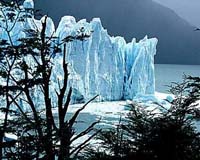| . |  |
. |
Kathmandu (AFP) Aug 28, 2009 South Asian ministers will gather in Nepal next week for talks on the threat that climate change poses to the Himalayas and to the 1.3 billion people dependent on water flowing from the mountains. Experts say the Himalayan glaciers are melting at an alarming rate and with months to go before a key summit in Copenhagen, mountain nations are hoping to highlight the myriad of problems facing the region. Climate change campaigners refer to the Himalayas as the "third pole" and say the melting glaciers are the biggest potential contributors to rising sea levels after the north and south poles. But until now Himalayan governments have not come together to lobby for ambitious emission reduction targets at December's Copenhagen summit, which aims to seal a new international climate change accord. "Nepal's message needs to be heard, and the message of the mountains needs to be heard," said World Bank water and climate expert Claudia Sadoff, who is helping Nepal's government organise the August 31-September 1 conference. "The Himalayas have their own very real set of challenges, but there are also a lot of adaptation and mitigation opportunities in the mountains." Glaciers in the Himalayas, a 2,400-kilometre (1,500-mile) range that sweeps through Pakistan, India, China, Nepal and Bhutan, provide headwaters for Asia's nine largest rivers, a lifeline for the 1.3 billion people who live downstream. But temperatures in the region have increased by between 0.15 and 0.6 degrees Celsius (0.27 and 1.08 degrees Fahrenheit) per decade for the last 30 years, and the effects are already being felt. In Nepal and Bhutan, the melting glaciers have formed vast lakes that threaten to burst, devastating communities downstream. Low-lying Bangladesh has always been prone to flooding, but leading environment scientist Atiq Rahman said the speed at which the Himalayan glaciers were melting meant floods were now "more frequent and more vigorous". Last year Nepal suffered its driest winter in 40 years, bringing the first widespread forest fires the country has experienced and destroying crops that depend on the winter rains. Campaigners say that while the effects of climate change on low-lying South Asian countries such as Bangladesh and the Maldives are now well known, there is little international awareness of the vulnerability of the Himalayan region. "The general impression is that the Himalayas are huge, impregnable, pristine spaces no one can hurt. But the fact is that they are melting," said Tariq Aziz, leader of the WWF's Living Himalayas initiative. "The Himalayas are not just mountains. They are a source of sustenance for millions and their most valuable commodity is water." Nepal's government, which has invited environment ministers from across South Asia to attend the talks, said it hoped to "take a regional voice on climate change to Copenhagen". "The glaciers are melting and the temperatures are rising in the Himalayas," said environment secretary Uday Raj Sharma. "This will ultimately affect people's livelihoods not only in Nepal but also downstream." Some observers have expressed concern that India, which opposes binding carbon emission cuts, will drown out the voices of smaller countries such as Nepal, Bhutan and Bangladesh at the Copenhagen talks. New Delhi does not plan to send anyone from the national government to next week's conference in Nepal, an absence that will inevitably weaken any message that comes out of the talks. India's environment secretary Jairam Ramesh recently expressed scepticism as to whether the melting of the Himalayan glaciers is caused by climate change, saying more research was needed. But campaigners say the world cannot afford to wait for concrete evidence before acting to mitigate the effects of the melting glaciers. They say poor mountain states such as Nepal and Bhutan need urgent international assistance to adapt to the changes and to build early warning systems necessary to prevent devastation from flooding or drought. "There is still debate on the magnitude of the effects of climate change but the consensus is that already, man-made emissions have created temperature increases," said Simon Lucas, climate change adviser to Britain's Department for International Development in Nepal. "We already know it is the poorest people who will be worst affected, and the number of people impacted in South Asia will be simply enormous." Share This Article With Planet Earth
Related Links Beyond the Ice Age
 Long Debate Ends Over Cause And Demise Of Ice Ages
Long Debate Ends Over Cause And Demise Of Ice AgesCorvallis OR (SPX) Aug 14, 2009 Researchers have largely put to rest a long debate on the underlying mechanism that has caused periodic ice ages on Earth for the past 2.5 million years - they are ultimately linked to slight shifts in solar radiation caused by predictable changes in Earth's rotation and axis. In a publication to be released Friday in the journal Science, researchers from Oregon State University and other ... read more |
|
| The content herein, unless otherwise known to be public domain, are Copyright 1995-2009 - SpaceDaily. AFP and UPI Wire Stories are copyright Agence France-Presse and United Press International. ESA Portal Reports are copyright European Space Agency. All NASA sourced material is public domain. Additional copyrights may apply in whole or part to other bona fide parties. Advertising does not imply endorsement,agreement or approval of any opinions, statements or information provided by SpaceDaily on any Web page published or hosted by SpaceDaily. Privacy Statement |